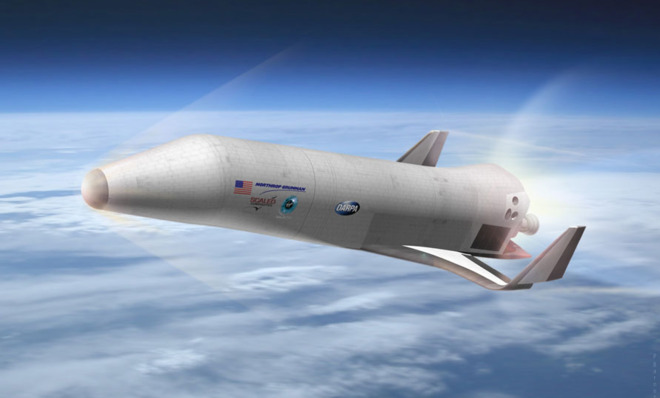Here comes the Pentagon's newest space plane
Think of it as a tiny, sub-orbital drone version of the Space Shuttle


We're entering a new era of space flight. The result — if all the new toys in development work — will be cheaper, lighter, and more frequent travels into space.
One example is the XS-1, a program to build a space plane led by the Defense Advanced Research Projects Agency. In August, Northrop Grumman — which is competing with Boeing and Masten Space Systems for a final contract — revealed a concept for its version of the craft.
It's designed to be unmanned and capable of lifting small and medium-size satellites into space — like a tiny, sub-orbital drone version of the Space Shuttle — before arching back down to Earth.
The Week
Escape your echo chamber. Get the facts behind the news, plus analysis from multiple perspectives.

Sign up for The Week's Free Newsletters
From our morning news briefing to a weekly Good News Newsletter, get the best of The Week delivered directly to your inbox.
From our morning news briefing to a weekly Good News Newsletter, get the best of The Week delivered directly to your inbox.
"It would be a spacecraft that most resembles what people see in the movies," Brian Weeden, a former officer with the Air Force's Space Command, tells War is Boring.
Right now, in order to launch a satellite, NASA has to spend around $55 million per single-use rocket launch. But DARPA's goal is to develop a reusable space craft that can handle a quick space flight — at $5 million per launch.
Instead of spending months planning to launch a single rocket in a limited window of time, the XS-1 could be ready again in days — or even hours. DARPA's goal is even more radical. The agency wants a plane that can carry out 10 launches in as many days.
"If we could pull it off, it would enable much cheaper and faster access to space," Weeden says. "Something that many people see as the key to opening up space development."
A free daily email with the biggest news stories of the day – and the best features from TheWeek.com
It wouldn't just mean civilian applications. The military is interested in how to deploy cheaper and smaller spy satellites. The Pentagon's National Reconnaissance Office already tests these mini-satellites, designed to help U.S. Special Operations Forces track terrorists.
But Weeden points out that making the dream into reality is "extremely difficult," he adds. "There are a lot of very challenging engineering problems to solve."
There's a reason why the history of space flight largely involved single-use spacecraft. Building a reusable craft means designing for a lot more moving parts, which adds further complexity to an already complex machine.
Another problem is that reusable craft land on surface runways instead of splashing down in the water, requiring shock absorbers in order not to damage sensitive instruments.
The vehicles are subjected to extreme heat upon reentry, which causes wear and tear that must be repaired. They're also really heavy, as they don't shed depleted fuel tanks and rocket boosters when ascending, as multi-stage rockets do.
But Northrop Grumman's design might get around this problem. The XS-1 is not supposed to be 100 percent reusable.
Rather, the XS-1 is a two-stage craft. The reusable part is the space plane itself. Once blasting off from its launch pad, the plane will ascend to a ballistic trajectory, "probably something very similar to Virgin Galactic's SpaceShip Two," Weeden says.
Next, the craft fires a single-use rocket carrying the satellite payload into low-Earth orbit. The space plane itself never enters orbit — though it does enter space.
"That seems to be a very wise trade-off," Weeden says. "It means that your final vehicle is not fully reusable, but it sidesteps a lot of the trickiest engineering problems."
The other advantage XS-1 has is in its materials. Northrop Grumman owns Scaled Composites, the Mojave, California-based company that designed SpaceShip Two's polymer hull. This might just be strong enough to handle sub-orbital flights — while also being much lighter than the metal hull of the now-retired Space Shuttle.
But technology doesn't exist in a vacuum, rhetorically speaking. There's practical and financial reasons for the Pentagon's interest in reusable craft. However, the U.S. also doesn't want to rely on Russia anymore to lift American satellites into orbit, especially after Russia's invasion of Crimea.
The U.S. still cooperates with Russia on the International Space Station — Russia is the only country with manned spacecraft involved with the ISS program — but NASA cut off other ties with the Russian Space Agency in April.
It's all part of the U.S.'s renewed interest in space — and a new space race. The Air Force also has its own space plane, the X-37. The plane's third mission recently ended after 674 days in orbit. NASA is likewise developing a new rocket and manned capsule to once again send astronauts into orbit. Once these systems are built, and if XS-1 works out, there will be drones up there, too.
From drones to AKs, high technology to low politics, War is Boring explores how and why we fight above, on, and below an angry world. Sign up for its daily email update here or subscribe to its RSS Feed here.
More from War is Boring...
-
 Guess the Number: January 2026
Guess the Number: January 2026Puzzles The daily number puzzle from The Week
-
 The Week’s big New Year’s Day quiz 2026
The Week’s big New Year’s Day quiz 2026Quiz of the Year How much do you remember about 2025’s headlines? Put yourself to the test with our bumper quiz of the year
-
 Is tanking ruining sports?
Is tanking ruining sports?Today's Big Question The NBA and the NFL want teams to compete to win. What happens if they decide not to?